商学部(塾外用) - 慶應義塾大学-塾生HP
商学部(塾外用) - 慶應義塾大学-塾生HP
商学部(塾外用) - 慶應義塾大学-塾生HP
Create successful ePaper yourself
Turn your PDF publications into a flip-book with our unique Google optimized e-Paper software.
LANGUAGE BEYOND GRAMMAR 2credits (Spring)<br />
日本語の話しことばと言外の意味 2単位 (春学期)<br />
LANGUAGE BEYOND GRAMMAR 2credits (Fall)<br />
日本語の話しことばと言外の意味 2単位 (秋学期)<br />
Expressing ‘something else’ beyond information— markers and<br />
functions in spoken Japanese<br />
Assistant Professor, Center for Japanese Studies<br />
KIM, ANGELA A.<br />
日本語・日本文化教育センター専任講師 キム, アンジェラ<br />
Course Description:<br />
Mastering the grammar of a particular language does not guarantee<br />
successful communication with a native speaker of that language.<br />
This is because language does not only function as a conveyance of<br />
information, but also has other functions such as expressing the language<br />
user’s attitude/emotions.<br />
The objective of this course is to encourage a more profound<br />
understanding of the functions of language that exist beyond referential<br />
meaning, with particular attention given to markers and their uses in<br />
conversations.<br />
An understanding of this aspect of language, and the function of<br />
particular markers, will lead to a deeper understanding of communication<br />
in general.<br />
This course comprises three main parts: (i) a general introduction to the<br />
non-referential function of language; (ii) the case of English briefly<br />
reviewing markers such as you know & I mean, like and just; and (iii) the<br />
case of Japanese including an overview of sentence-final particles, and<br />
markers such as ne, kedo, janai, datte, ano, maa etc.<br />
Textbooks:<br />
There is no prescribed textbook.<br />
Appropriate readings for every class will be provided the week prior in<br />
class. Please note that depending on enrolment numbers, you may need<br />
to purchase the copied reading material at your own expense.<br />
Reference Books:<br />
Cook, H. M. 1990a. The sentence-final particle ‘ne’ as a tool for<br />
cooperation in Japanese conversation. In H. Hoji (ed.) Japanese/Korean<br />
Linguistics 1.<br />
Stanford: CSLI Publications, 29-44.<br />
Cook, H. M. 1992. Meaning of non-referential indexes: A case study of<br />
the Japanese sentence-final particle ‘ne’. Text 12(4): 507-539.<br />
Fukada-Karlin, A. 2003. Functions of the attitudinal discourse maker<br />
‘maa’ in Japanese conversation. In P. Clancy (ed.) Japanese/Korean<br />
Linguistics 11. Stanford: CSLI Publications, 53-66.<br />
Jucker, A. H. and S. W. Smith. 1998. “And people just you know like<br />
‘wow’” Discourse markers as negotiating strategies. In A. H. Jucker and<br />
Y. Ziv (eds.) Discourse Markers: Descriptions and Theory. Amsterdam/<br />
Philadelphia: John Benjamins Publishing Company, 171-201.<br />
Kawanishi, Y. 1994. An analysis of non-challengeable modals: Korean<br />
‘-canha (yo)’ and Japanese ‘-janai’. In N. Akatsuka (ed.) Japanese/Korean<br />
Linguistics 4. Stanford: CSLI Publications, 95-111.<br />
Martin, Samuel E. 1975. A reference Grammar of Japanese. New<br />
Haven:Yale University Press.<br />
Maynard, S. K. 1997. Japanese Communication: Language and<br />
Thought in Context. Honolulu: University of Hawaii Press.<br />
Maynard, S. K. 1998. Principles of Japanese Discourse. Cambridge:<br />
Cambridge University Press.<br />
Maynard, S. K. 2001a. Koisuru Futari no ‘Kanjyoo Kotoba’ [Emotive<br />
Language between the Lovers]. Tokyo: Kuroshio Shuppan.<br />
Maynard, S. K. 2001b. Nihongo bunpoo to kanjoo no setten — terebi<br />
dorama ni kaiwa bunseki o shiyoo shite — [Where Japanese grammar and<br />
emotions meet — applying conversation analysis to television drama —].<br />
Nihongo Bunpoo [Journal of Japanese Grammar] 1(1): 90-110.<br />
McGloin, N. H. 1999. The rhetorical negative question form, ‘zyanai<br />
desu ka’. In M. Muraki and E. Iwamoto (eds.) Linguistics: In Search of<br />
91<br />
the Human Mind: A Festschrift for Kazuko Inoue. Tokyo: Kaitakusha,<br />
452-469.<br />
Mori, J. 1994. Functions of the connective ‘datte’ in Japanese<br />
conversation. In Noriko Akatsuka (ed.) Japanese/Korean Linguistics 4.<br />
Stanford: CSLI Publications, 147-163.<br />
Schiffrin, Deborah. 1987. Discourse Markers. Cambridge: Cambridge<br />
University Press.<br />
Tannen, D. 1984. Conversational Style: Analyzing Talk among Friends.<br />
Norwood, NJ: Ablex Publishing Corporation.<br />
Tannen, D. 1992. That’s Not What I Meant!: How Conversational Style<br />
Makes or Breaks Your Relations with Others. London: Virago.<br />
Tannen, D. 2001. You Just Don’t Understand: Women and Men in<br />
Conversation. New York: Quill.<br />
Östman, J-O. 1981. You know: A Discourse Functional Approach.<br />
Amsterdam: John Benjamins B.V.<br />
TWENTIETH-CENTURY JAPANESE AND WESTERN SHORT<br />
FICTION 2credits (Spring)<br />
20世紀の日本と欧米の小説 2単位 (春学期)<br />
Comparative Readings<br />
Professor, Faculty of Law RAESIDE, JAMES M.<br />
法学部教授 レイサイド, ジェイムス M<br />
Course Description:<br />
In these classes we will attempt to understand something of the nature<br />
of the short story and of Japanese short fiction in particular by a close<br />
reading of Japanese texts together with others by Western (European and<br />
American) writers.<br />
Each class will focus on a pair of texts: one by a Japanese and one by<br />
an American or European writer. The texts chosen will be relatively short:<br />
wherever possible, complete short stories. All texts will be discussed on<br />
the basis of their English language translations and the language of<br />
discussion will be English. However, the original Japanese texts will also<br />
be distributed on request and native speakers of Japanese are particularly<br />
encouraged to use their knowledge of the original language to add to the<br />
discussion. Those students with knowledge of European languages other<br />
than English are also welcome to use this knowledge in discussion, where<br />
appropriate. However, the original versions of texts in languages other<br />
than Japanese will not be provided. In any case, it is imperative to the<br />
functioning of the class that all participants make time to read the set texts<br />
beforehand, and be prepared to talk about them in detail. Only those who<br />
have made this effort will be able to participate usefully in the discussion.<br />
The texts will be read in roughly chronological order.<br />
Textbooks:<br />
Since the texts will be taken from various sources, photocopies will be<br />
used. However, given the likely volume of paper, students may be<br />
charged at 10 yen per page.<br />
Reference Books:<br />
The Columbia Anthology of Modern Japanese Literature: From 1945 to<br />
the Present. Ed J. Thomas Rimer and Van C. Gessel.<br />
Modern Japanese Short Stories. Ed. Ivan Morris.<br />
The Oxford Book of Japanese Short Stories . Ed. Theodore Goossen.<br />
The Showa Anthology: Modern Japanese Short Stories, 1961-1984. Ed<br />
Van C Gessel & Tomone Matsumoto.<br />
THE AWAKENING 2credits (Spring)<br />
目覚め 2単位 (春学期)<br />
The Awakening<br />
Professor, Faculty of Letters ARMOUR, ANDREW J.<br />
文学部教授 アーマー, アンドルー J<br />
Course Description:<br />
Japanese prose literature of the modern period will be discussed in this<br />
lecture course. In “Journey Through the Floating World” last summer, we<br />
covered the pre-modern literature of the Tokugawa period, an era that<br />
came to an abrupt end with the Meiji Restoration of 1868. The resulting<br />
political and social upheaval had a traumatic effect on many aspects of<br />
諸<br />
研<br />
究<br />
所




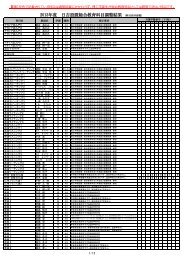
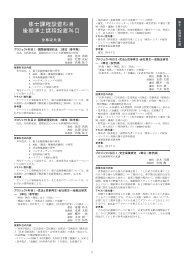
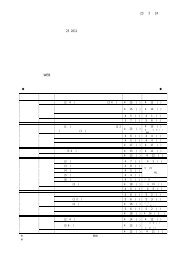
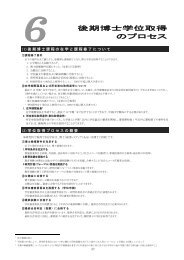
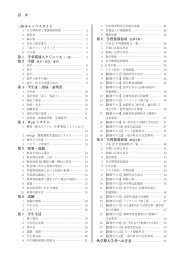



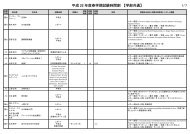

![文学部時間割表[2 ・3年生(07学則)]](https://img.yumpu.com/21046130/1/184x260/2-307.jpg?quality=85)

